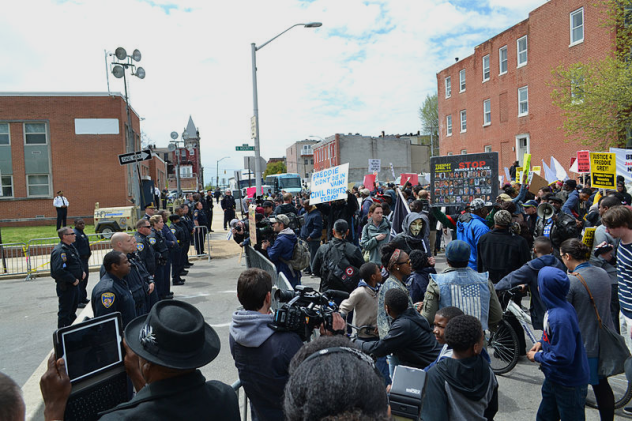 Movies and TV
Movies and TV  Movies and TV
Movies and TV  Creepy
Creepy 10 Eerie & Mysterious Ghosts of the Pacific Coast
 Weird Stuff
Weird Stuff 10 Typos That Accidentally Changed History
 History
History 10 Times Trickery Won Battles
 Technology
Technology 10 Awesome Upgrades to Common Household Items
 Misconceptions
Misconceptions 10 Hilarious (and Totally Wrong) Misconceptions About Childbirth
 Weird Stuff
Weird Stuff 10 Warning Labels That Exist Because Someone Actually Tried It
 Health
Health Ten Confounding New Inventions from the World of Biomedicine
 Creepy
Creepy 10 Death Superstitions That Will Give You the Creeps
 Movies and TV
Movies and TV 10 Movies That Get Elite Jobs Right, According to Experts
 Movies and TV
Movies and TV 10 Most Realistic Medical TV Shows of All Time
 Creepy
Creepy 10 Eerie & Mysterious Ghosts of the Pacific Coast
 Weird Stuff
Weird Stuff 10 Typos That Accidentally Changed History
Who's Behind Listverse?

Jamie Frater
Head Editor
Jamie founded Listverse due to an insatiable desire to share fascinating, obscure, and bizarre facts. He has been a guest speaker on numerous national radio and television stations and is a five time published author.
More About Us History
History 10 Times Trickery Won Battles
 Technology
Technology 10 Awesome Upgrades to Common Household Items
 Misconceptions
Misconceptions 10 Hilarious (and Totally Wrong) Misconceptions About Childbirth
 Weird Stuff
Weird Stuff 10 Warning Labels That Exist Because Someone Actually Tried It
 Health
Health Ten Confounding New Inventions from the World of Biomedicine
 Creepy
Creepy 10 Death Superstitions That Will Give You the Creeps
 Movies and TV
Movies and TV 10 Movies That Get Elite Jobs Right, According to Experts
10 Ways Organizations Manipulated Social Media For Political Agendas
Throughout history, governments and interest groups have used the communications methods of the day to spread their messages, from royal proclamations to radio broadcasts to state-approved propaganda cinema. Today is no different. China is perhaps the most famous example of a government that is up to dirty tricks online, but it is far from the only case.
10 The Tweets Of The Ayatollah
Iran’s Ayatollah Khamenei maintains Twitter accounts for a number of reasons. One is for occasionally communicating with a domestic audience in Farsi. Another is for foreign audiences, with posts in English, Spanish, and Arabic, usually intended to spread the Iranian state line on international issues and also to attack Israel, ISIS, and the United States. The account isn’t verified, and Iran won’t confirm who’s tweeting, but it’s generally considered to be managed by the Ayatollah’s office. The photos and videos indicate that the Iranian government is involved, at the very least. The account pulls no punches when it comes to getting involved with internal situations in enemy nations.
In 2014, Khamenei included the hashtag “#Ferguson” in order to enter the raging US debate over race relations, where the Ayatollah accused America of racial discrimination and subjugation of African Americans. These included: “Today like previous years, African-Americans are still under pressure, oppressed and subjected to discrimination. #Ferguson,” and “In 1992 a popular uprising protesting the blatant oppression of black ppl couldn’t be subdued by the police so #army got involved. #Ferguson.” He later made use of other inflammatory hashtags, like “#Waco.”
In 2015, the Ayatollah sent a rather unambiguously threatening tweet of a silhouetted President Obama holding a gun to his head, with the message, “U.S. president has said he could knock out Iran’s military. We welcome no war, nor do we initiate any war, but if any war happens, the one who will emerge (the) loser will be the aggressive and criminal U.S.” Ironically, the tweet came three days after a historic agreement limiting Iran’s nuclear capability in exchange for the loosening of economic sanctions.
9 Scientology’s Documentary Smear Campaign

When Alex Gibney’s documentary Going Clear: Scientology and the Prison of Belief was to air on HBO in March 2015, the cult scrambled to respond on social media while keeping their hands clean. Much of the documentary focused on the dark history of the church and its dirty laundry, being harshly critical of the corruption and abuse of founder L. Ron Hubbard, current leader David Miscavige, and celebrity spokesman Tom Cruise.
Through the Twitter account of the Scientology tabloid organ Freedom Magazine, the church attacked the filmmakers as biased, lying home-wreckers without any friends, “bitter vengeful apostates,” and “admitted perjurers, admitted liars and professional anti-Scientologists.” They paid money to Twitter to promote their tweets, ensuring that Scientology propaganda would appear as the top result for “#GoingClear” searches, and posted tweets attacking Gibney as a propaganda artist who abused his ex.
As the airdate loomed, they switched to posting stock pictures of people asleep at movie theaters, claiming the documentary was “talking heads, insufferable music, way too long . . . Zzzzzzzz.” Hilariously, the discrediting campaign only served to further promote the film, with the Twitter-spamming tactics seeming to back up the documentary’s arguments against the organization. Many simply laughed at the ham-handed attempt at propaganda or criticized Twitter for selling promoted tweets to a cult.
8 Russia’s War On Emoji
Anti-homosexual sentiment in Russia is rife. Gay rights activists are harassed and attacked by Orthodox Christian and pro-government counterprotesters, and lawmakers are passing stringent anti-gay legislation under the guise of “protecting children.” The war took a turn for the ridiculous in late July 2015, when it was revealed that a law passed in 2013 forbidding the promotion of nontraditional sexual relationships may be used to target emoji deemed as “homosexual propaganda.”
Russian senator Mikhail Marchenko claimed to have received complaints about emoji featuring smiling homosexual couples, which Apple introduced to its operating system in 2012 and followed up in 2015 with emoji featuring happy gay couples with children. According to far-right Liberal Democratic Party Senator Marchento, the symbols “promoted non-traditional sexual relationships,” “denied family values,” and showed “disrespect for parents and other family members.”
Internet enforcement body Roskomnadzor asked the youth group of President Vladimir Putin’s political party, the Young Guard, to investigate and report on the matter. One Young Guard spokesman said the group had not yet received a formal request to investigate, but they were “ready to deal with the protection of rights on the Internet under Russian law.” One of the first victims of the “gay propaganda” laws was the founder of Children-404, an online community for LGBT teenagers in Russia, who was fined 50,000 roubles (about $830) after being found guilty of “propaganda of non-traditional sexual relations among minors.”
7 The Aam Aadmi Party’s Social Media Strategy
The surprising and decisive victory in Delhi elections by the Aam Aadmi Party (AAP) over their rivals, the Bharatiya Janata Party (BJP) and the Indian National Congress (INC), was due to a number of factors. Their leader, Arvind Kejriwal, was seen as a charismatic man of the people whom the party leadership rallied around, and the party had an appealing policy of responding to issues faced by common people while giving dignified responses to political attacks by the BJP.
Another factor considered significant in their victory has been their adept use of social media. According to Facebook data, the AAP dominated online interaction with citizens with 27.8 million engagements, while the BJP was at 8.4 million and INC at only 5.1 million. As print, electronic media, traditional news sources, and user-generated content have been becoming increasingly integrated in India, the active social media strategy paid off for the AAP.
Perhaps the most interesting development was an algorithm developed by 10 volunteers at the Indian Institute of Technology Bombay in Mumbai. The research tool was designed to analyze the language used in thousands of tweets and Facebook posts to determine voter sentiment toward key events and issues as negative, weakly negative, neutral, weakly positive, or positive. The results were reviewed manually by volunteers who sent reports to the AAP headquarters in Delhi. This way, the party could avoid issues deemed “negative” by the electorate and focus on issues that voters deemed more important, such as women’s safety. Some believe the strategy helped the AAP to respond and react to public opinion more quickly and successfully than more conservative and tone-deaf parties like the BJP.
6 Political Cookies

Cookies, the bits of code which identify your computer online, are usually used to tailor what consumer product advertisements appear for you as you browse the web, based on your history. But in 2012, there was a bit of controversy over the fact that it wasn’t just private companies who could access that data, but also political campaign managers. It was possible for campaign managers to compare your browsing history with publicly available information such as your political party registration, your voting history, charitable donations, your address, your age, and your hobbies. This allowed political campaigns to “microtarget” individual voters with messages and advertising on social media that were more likely to resonate with them on a gut level.
Quite a few people took issue with this idea. Jeff Chester, executive director of the Center for Digital Democracy, told website Idea Lab, “These are not your mom and pop TV ads. These are ads increasingly designed for you—to tell you what you may want to hear.” The whole problem with microtargeting and the manipulation of political cookies is that it bypasses the public sphere and civil debate. Instead of exposure to differing opinions and competing ideals, individuals may have their private politics analyzed and manipulated by the major parties.
Politicians could simply tailor messages for each individual’s predispositions, self-identification, and biases, without any need to persuade the public as a whole on the wisdom of the policy and leadership. This could prove disastrous for the continued prosperity of liberal democracy, dividing it at the fundamental base, the common people.
5 Baltimore Police Twitter Narrative

During the 2015 Baltimore Uprising, the fighting on the streets was mirrored by a conflict over a narrative waged on social media. Many claimed that the police were using Twitter to push their own perspective on events, mixing factual information and safety advisories with editorialized tweets and manipulated language. As mourners were gathering for the funeral of Freddie Gray, a man who died in police custody, Baltimore police warned of a “credible threat to law enforcement,” with local gangs supposedly uniting with the goal of killing police officers.
The Bloods, the Crips, and the Black Guerrilla Family had indeed formed a truce, but they claim it was to maintain the peace and to show respect for Freddie Gray during a demonstration at Baltimore’s City Hall. One gang member told a police reporter: “We did not make that truce to harm cops. To stop what’s going on—that’s all we’re trying to do. We want justice for Freddie Gray.”
This was not an isolated incident. Baltimore police also posted tweets that twisted and manipulated the facts behind events, while consistently using words like “criminals” to describe protesters who had not been convicted of any crime. One tweet read, “A group of criminals have just started a fire outside the library located at Pennsylvania Ave and North Ave,” while the Guardian reported that the fire had actually been caused by sparks from police tear gas grenades.
Another incident had the department tweeting, “A group of juveniles in the area of Mondawmin Mall. Expect traffic delays in the area,” before police in full riot gear arrived outside a high school as classes were finishing, shut down the bus and subway stations, and trapped a large group of students in, arguably causing a situation that may never have occurred otherwise.
In response, activists have also been using social media to refocus attention away from looting onto the social and economic issues underlying the uprising. They created a website called BaltimoreUprising.org to provide information so that people could start to clean up communities, gather for further protests, feed children who missed free school lunches, and find churches to seek refuge.
4 JTRIG’s Dirty Tricks
Among the secret documents released by Edward Snowden, there were a number of documents from the Government Communications Headquarters (GCHQ), the British equivalent to the NSA. The GCHQ had formed a secret unit known as the Joint Threat Research Intelligence Group (JTRIG), which developed a variety of “dirty trick” tactics to be used not only against foreign national threats like Iran, but also civilian targets like Anonymous and other “hacktivists.” These were presented by the GCHQ to the NSA and the three other members of the Five Eyes Alliance—Canada, New Zealand, and Australia. Snowden released the GCHQ’s PowerPoint presentation files, which were then reported on by NBC in 2014.
JTRIG’s aims were to “destroy, deny, degrade [and] disrupt” enemies and targets online by injecting false material onto the Internet to discredit them, as well as use social science and other research to control and manipulate online discourse. Many of the techniques aimed at individual targets involved manipulation of social media such as deleting a blog or other account, setting up online honey traps, or changing a person’s photos on a social networking site. They also include a variety of “false flag” operations, such as setting up a fake blog account pretending to be a sexual victim of the individual target or posting negative information about a target company on Internet forums.
These documents were the first to prove that a Western government is using controversial techniques to attack targets and spread disinformation online. Much of the issue with these techniques is that they are the same much-criticized techniques used by hacktivists. Also, they indicate that Western governments are willing to use deception-based online tactics designed to destroy the reputations of individuals who have never been convicted of a crime. While such techniques are often used to address national security threats, it is not difficult to see how they could be misused to silence dissent or discredit legitimate critics of the government.
3 ZunZuneo
In April 2014, the Associated Press uncovered a secret operation by the US Agency for International Development (USAID) to create a Twitter-like social media platform through cellphones to evade Havana’s strict information controls and censorship of the Internet. It was called ZunZuneo, based on Cuban slang for a hummingbird’s tweet. The plan was to build a subscriber base for the network by pushing news updates on noncontroversial topics like soccer, music, and incoming hurricanes. Once the network had a solid subscriber base, it started to introduce explicitly political material in the hopes of organizing political flash mobs and causing a “Cuban Spring.” At its height, the network had around 40,000 subscribers, none of whom were aware that ZunZuneo was funded by the United States government.
The US government insisted that the program was not technically a “covert” operation but rather a “discreet” operation. The US Senate Foreign Relations Committee demanded that USAID hand over records related to ZunZuneo for review. Senator Jeff Flake asked, “Will we have access to all the tweets or the messages that were sent by USAid or its contractors in full so we can judge here? Because we have to provide oversight, whether we authorize programs or fund them.”
Many in the government were in favor of the program in spite of USAID having kept them in the dark about it earlier. However, the Huffington Post detailed some potential downsides: The fallout over the revelation could spook the Cuban people about US intentions and encourage more repression by Havana. The involvement of USAID could make Havana more wary of allowing foreign companies to operate on its soil in spite of desperately needing investment. Finally, the fact that ZunZuneo grew on the back of new private enterprise laws passed by Raul Castro could stymie the development of entrepreneurship in the country.
2 DARPA Studies

In 2014, studies directly or indirectly funded by the US Department of Defense’s Defense Advanced Research Projects Agency (DARPA) explored how social connections are made and how messages are spread on social networking sites like Facebook, Twitter, Pinterest, and Kickstarter. This was included under a list of projects funded under DARPA’s Social Media in Strategic Communication (SMISC) program. Objects of study included the spread of memes through the Internet and how to influence online behavior such as liking, following, and retweeting. Some of the funding went toward analysis of the Twitter feeds of celebrities like Lady Gaga and Justin Bieber.
The stated aim of the program, launched in 2001, was as follows: “The general goal of the Social Media in Strategic Communication (SMISC) program is to develop a new science of social networks built on an emerging technology base. Through the program, DARPA seeks to develop tools to support the efforts of human operators to counter misinformation or deception campaigns with truthful information.”
Some of the studies were eyebrow-raising. One collected tweets from 2,400 Twitter users residing in the Middle East to analyze their online interactions. Another focused on domestic Twitter discussion on controversial issues like fracking, raising taxes, genetically modified organisms, and the death penalty. While the idea of dealing with deception and misinformation isn’t bad in and of itself, the documents presented to the Five Eyes Alliance outlined ways to manipulate social media to target individuals and other issues like metadata retention. You don’t have to be a conspiracy theorist to fear the increasing online influence of the government.
1 Islamic State Online

In 2015, the US State Department released an internal assessment analyzing what success the Obama administration and foreign allies have had in opposing the online propaganda efforts of the Islamic State, and the prognosis was dire. The State Department maintains the Center for Strategic Counterterrorism Communications, employing specialists fluent in Arabic, Urdu, Punjabi, and Somali to combat the ISIS narrative online. They also post messages on websites that jihadists use for recruitment, fund-raising, and promotion.
One of the main issues is that while ISIS has a clear and consistent message, it is difficult to get the US and its allies on the same page as to how to most effectively combat ISIS’s presence on the Internet and social media. An attempt to bring together a working group between the US, UK, and UAE is floundering because, “The UAE is reticent, the Brits are overeager, and the working group structure is confusing.”
ISIS, by contrast, has shown itself to have a brutal finesse in manipulating and managing social media. Military offensives and slaughters are broadcast on Twitter with trending hashtags, while sharply edited YouTube clips resembling Hollywood movie trailers are regularly uploaded. Michael O’Hanlon, a Brookings Institution senior fellow specializing in defense and foreign policy, believes that ISIS’s social media prowess has helped the terrorist group immensely: “Its glossy, glitzy, romanticized version of jihad and the caliphate it is trying to create—even if seriously perverted and twisted and brutal by any fair standard—is made to seem appealing by truly expert propaganda.”
On the other hand, social media can also backfire on ISIS. According to political science professor Max Abrahms: “What the social media alarmists ignore is that social media can increase not just the recruitment rate, but also the attrition rate. Not only are many Islamic State terrorists caught or killed via social media, but the propaganda can motivate governments into adopting a more robust counterterrorism response.” One recent incident involved a jihadi posting a selfie near an ISIS headquarters building in Syria. Within 24 hours, the location was identified, and the US Air Force destroyed it with smart bombs.
David Tormsen’s social media presence is only 30 percent for political manipulation. Email him at [email protected].








